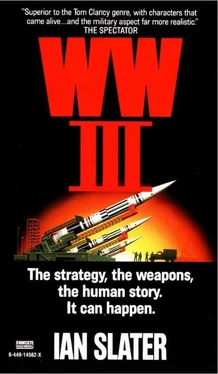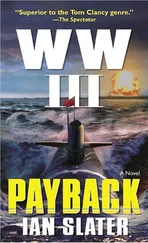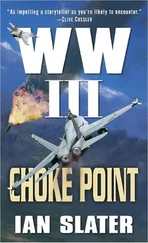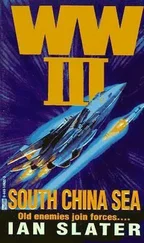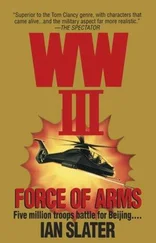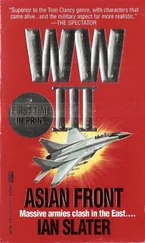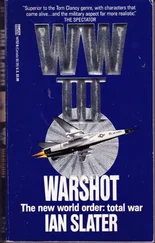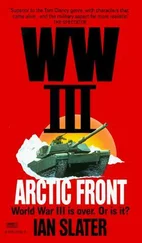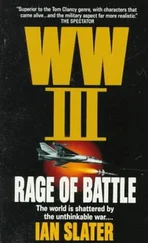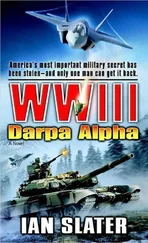“Sink them, Mr. Rees!”
“Very good, sir.”
The Sheffield destroyer, holed abaft and sinking quickly, listing dangerously over, her pumps working overtime, led the attack, with her 115-milimeter forward gun pumping away at the first big ocean-going trawler, flecks of paint and rigging spitting up into the air above her. The fish boat turned tail, its stern now to the destroyer; the high-piled netting seemed to shrivel up and fall away. There was an orange wink. Two other trawlers were doing the same.
“Skimmer midships!” shouted the destroyer’s starboard lookout. A split second later the destroyer’s radar, which activated the close-in Phalanx system, began firing. The destroyer’s radar mast collapsed on the bridge as the Sea Dart roared off from its weather deck mount. But the list of the Sheffield was so acute that only the 115-milimeter gun could depress far enough to do any damage, the Gatling gun effectively raking only the trawler’s wheelhouse. The trawler suddenly bucked, its stem lifted clean out of the water by the force of a British destroyer’s Exocet — but not before the trawler and two of its sister craft had fired four fifty-five-hundred-pound Styx surface-to-surface missiles. Two of them missed, or rather were exploded by in-close Gatlings. The other two hit. The entire superstructure and bridge of the next ship in the line, a sleek Leander-class frigate, were engulfed in fire, her radar and radio masts collapsing into the hot maze of twisted steel like a long-legged insect, the crescent-shaped radar antenna aglow as it struck the water, and temperatures generated so high that the port side lifeboat was incinerated amid the reek of cordite, gasoline, and burning bodies, other men spilling into the sea, many of them afire. And methodically, above the sound of the screaming men, the steady pump-pump-pump of cannon fire pulverizing the remaining trawlers.
Several of the officers aboard the long line of British, Dutch, and German escorts had difficulty stopping their gunners even after it was obvious that the trawlers were well and truly done for. Among some men it had been an unwritten contract in a war that they knew would be waged with the speed and force of missiles. There would be no time for such old-fashioned notions as rescue. Better a bullet than to be left drowning in oil.
* * *
By now it was dusk, and as the convoy re-formed in squares, the Dutch minesweeper leading, Woodall ordered all ships to turn south again in a wide arc, avoiding the area where the trawlers had sown their deadly harvest. But only he, among the entire complement of the cruiser and all the other ships, knew that R-1 had been an experiment — with the empty container ships as decoys. As another admiral before him, Mountbatten, had sent the Canadian Corps to invade a beach in Normandy to test the theory for D-Day, to see if it could be done, Woodall was now seeing if “rollover” was feasible. And as Mountbatten had hoped to draw out the Luftwaffe during the Dieppe raid, now R-1 was to draw out the Russians for the killing. The Dieppe raid had been a terrible failure — more than two-thirds killed, the rest taken prisoner — but from it came the invaluable lessons of D-Day.
The men like Horton in charge of “rollover” had to know as quickly as possible whether the square base, fan-shaped screen convoy was workable in real combat. But the awful thing for Woodall was that now that it had been tried in actual battle conditions, the first time in modern missile warfare, he knew he could not give SACLANT or anyone else a definitive answer, other than to say that the Soviets had very effectively attacked the convoy by deception, using mines to devastating effect. Without question, it was a terrible loss for the convoy, eight of the container ships sunk, two escorts, a total of over four hundred men dead. But the Russian subs, the more telling test for the long-run strategy, had not appeared at all. So far.
Again Woodall wondered what was happening at the GIUK Gap, where NATO had laid its noise-signature-primed mines.
ACCHAN in Northwood, U.K., had replied that as yet no explosions had been picked up by the GUIK SOSUS network or by any towed sonar arrays.
The only good piece of news Woodall received was that Greenland’s ice sheet was farther out than usual for September, making the Greenland-Iceland Gap even narrower, so that if the Soviet subs were going to break out, it would most likely be through the Iceland-Faeroe gap as they rounded Norway’s north cape.
“That would narrow the field,” the cruiser’s captain commented to Woodall.
“Possibly,” answered the admiral, “unless they used the ice sheet as cover.”
“Then they’d have to bust through, sir. Make a hell of a din. Could hear it in Piccadilly.”
“No,” said Woodall, “they could use the sheet as cover until they’re well south of the main channel, then break out on their left flank at speed — into open water.”
“There’s still our mines,” said the cruiser’s captain.
“Then why haven’t our listening posts in Iceland heard them popping off?” pressed Woodall.
“Yes, unless—” The captain could see that the admiral had already thought of it, too — the possibility of it — the trawlers being the tip-off. “Bloody hell, sir. Special forces?”
“Yes,” replied Woodall. “Bastards might have wiped out the listening posts. Either that or been digging up the damned SOSUS lines.”
“Dragging them up would be tricky,” commented the captain. “Take an age, too.”
“I agree,” said Woodall, worriedly, his eyes roaming the leaden horizon as night began its descent. “I’d say we’re not hearing anything because the—”
“Lines have been closed,” put in the captain, as eager as Woodall for an explanation.
Woodall was pacing back and forth across the cruiser’s bridge, oblivious to the winking lights of the steering console and the phosphorescent sweep of the radar’s arm. “I’d say the posts are still operational but are being run by the SPETS. They’ve deactivated the mines from shore-control relay. We’re being fed silence.” He stopped walking, looking across at the cruiser’s captain. “Everything’s seeming normal to us — even a little static on the line.”
“How about the call-in code checks they’d have to answer?”
“Broken the code, old boy. Or more likely they’ve been sold the bloody things. Some pretty East German secretary in Bonn, no doubt — slipping her boss a bit more than rollover.”
“I don’t like that much,” said the captain.
“Neither do I. Those subs could be breaking out right now.”
They were both quite wrong. No listening stations had been overrun — NATO had given top priority to defending them — nor was the sub fleet that had come out of the Kara Sea and around the Kola Peninsula in the process of breaking out. They had already done so. Hours before.
Uijongbu
In the morning Tae had told the NKA interrogation officer, Major Rhee, albeit politely, that he would not cooperate. The NKA pulled two teeth with pliers. Tae blacked out for a second or two, but once conscious again, shook his head, refusing to tell them anything beyond his rank, name and ROK identification number. Rhee told him kŭsaramtŭl orarŭl chikae kŭchinkuhante sikanŭl nangpihae —they weren’t going to fuck around with him — and sent him back to the schoolhouse cell, his hands still bound behind his back. When they came for him later, it was late in the afternoon, the sun out briefly, making steam for the rice paddies. He was pushed roughly inside the bleak, musty-smelling interrogation tent, its hanging light bulb swinging slightly in the wind.
Читать дальше
